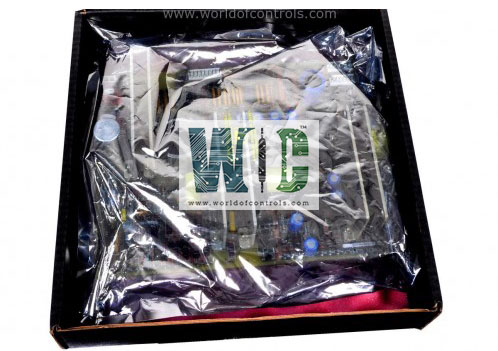SPECIFICATIONS
Part No.: IS230TREA1AG01
Manufacturer: General Electric
Country of Manufacture: United States of America (USA)
Size: 33.0 cm high x 17.8 cm, wide (13 in. x 7 in.)
Technology: Surface mount
Temperature: -30 to 65oC
Product Type: Turbine Emergency Trip Terminal Board
Availability: In Stock
Series: Mark VIe
Functional Description
IS230TREA1AG01 is a Turbine Emergency Trip Terminal Board developed by GE. It is a part of the Mark VIe control system. The turbine emergency trip terminal board, an integral part of the Mark VIe system, collaborates with PPRO turbine I/O packs to ensure swift response during emergencies. It features customer input terminals accessible via two 24-point pluggable barrier terminal blocks, offering convenient connectivity and facilitating installation and maintenance. This modular design enhances flexibility and reliability while safeguarding turbine operations in critical situations.
Dedicated Speed Inputs
- When used in conjunction with PPRO I/O packs directly mounted on the TREA, the speed inputs offer users the flexibility of two distinct configuration options.
- In the first scenario, each PPRO I/O pack has the capability to receive a dedicated set of three speed inputs from their corresponding TREA terminal points, mirroring the configuration commonly found with SPRO setups.
Fanned Speed Inputs
- Alternatively, users can opt for a more consolidated approach by employing jumpers P1 and P2 on the TREA. This configuration allows the first three speed inputs, typically designated for the X pack, to be fanned out and distributed to the Y and Z packs.
- However, it's essential to note that with this setup, the terminal board points allocated for Y and Z speed inputs become inactive, effectively serving as no-connects. Consequently, these points should remain unused to avoid any operational complications.
Mismatch Detection and Alarm
- To ensure seamless integration and prevent configuration discrepancies, the PPRO incorporates a robust system for detecting mismatches between the jumper position and PPRO configuration.
- This detection mechanism is facilitated through a feedback signal provided by the TREA. In instances where such a mismatch is detected, triggering a misalignment between the jumper configuration and PPRO setup, the system promptly generates an alarm.
- This proactive alerting mechanism enables operators to swiftly identify and address any inconsistencies, thereby safeguarding system functionality and integrity.
Voltage Detection Inputs
- Min/Max Input Voltage Rating: The voltage detection inputs are designed to handle a wide range of input voltages, with a minimum rating of 16 V dc and a maximum rating of 150 V dc peak.
- Current Loading (Max Leakage): The module exhibits minimal current loading, with a maximum leakage current of 3 mA, ensuring efficient utilization of power resources.
- Detection Delay (Max): In terms of response time, the module boasts a detection delay of up to 60 ms, providing swift and reliable detection of voltage variations.
- Voltage Isolation:For enhanced safety and reliability, the voltage detection inputs feature optical isolation, offering a robust isolation rating of 2500 V rms for one minute.
- Surge/Spike Rating: The module is engineered to withstand transient voltage surges and spikes, with a surge rating of 1000 V peak for 8.3 ms, safeguarding against potential damage from electrical disturbances.
ESTOP/TRP Detection Input
- Voltage Range: The ESTOP/TRP detection input accepts voltages within the range of 24-125 V dc, with a tolerance of 10% and minimum/maximum peak ratings of 18/150 V pk.
- Loading (Max): The maximum loading for this input is 12 mA, with a typical loading of 5 mA, ensuring minimal impact on the overall system power consumption.
- Delay (Max): The detection delay for ESTOP/TRP signals is limited to a maximum of 5 ms, with a typical delay of less than 1 ms, ensuring rapid response in critical situations.
MPU Pulse Rate Characteristics
- Pulse Rate Range: The MPU (Main Processing Unit) pulse rate can vary between 2 Hz to 20 kHz, offering versatility in signal processing and data acquisition.
- Pulse Rate Accuracy: With an impressive accuracy of 0.05 percent of the reading, the module ensures precise measurement and control of pulse rates, contributing to system reliability and performance.
- Input Circuit Sensitivity: The MPU input circuit exhibits high sensitivity, capable of detecting pulses as low as 27 mV peak, enabling the detection of subtle changes in speed or frequency, such as a 2 rpm speed variation.
The WOC team is always available to help you with your Mark VIe requirements. For more information, please contact WOC.
Frequently Asked Questions
What is IS230TREA1AG01?
It is a turbine emergency trip terminal board developed by GE under the Mark VIe series.
What is the pulse rate range of the MPU?
The MPU's pulse rate range spans from 2 Hz to 20 kHz, offering versatility in signal processing and data acquisition across a wide spectrum of frequencies.
How accurate is the MPU's pulse rate measurement?
The MPU boasts an impressive pulse rate accuracy of 0.05 percent of the reading, ensuring precise measurement and control of pulse rates, contributing to system reliability and performance.
What is the sensitivity of the MPU input circuit?
The MPU input circuit exhibits high sensitivity, capable of detecting pulses as low as 27 mV peak, enabling the detection of subtle changes in speed or frequency, such as a 2 rpm speed variation.
